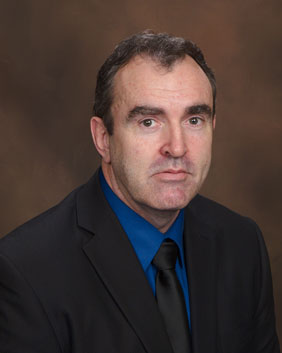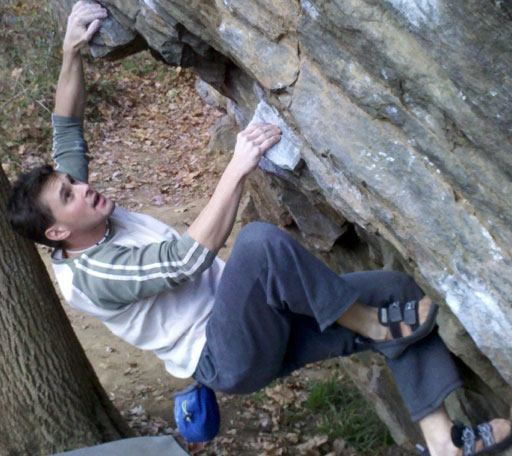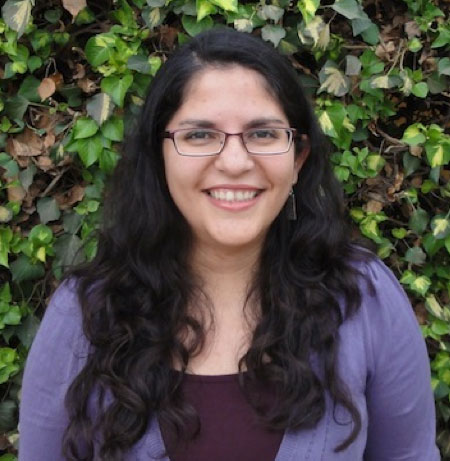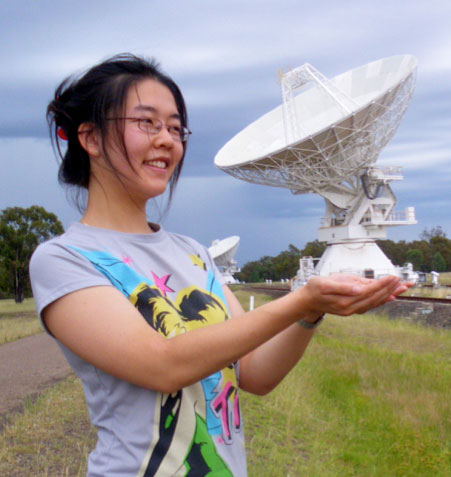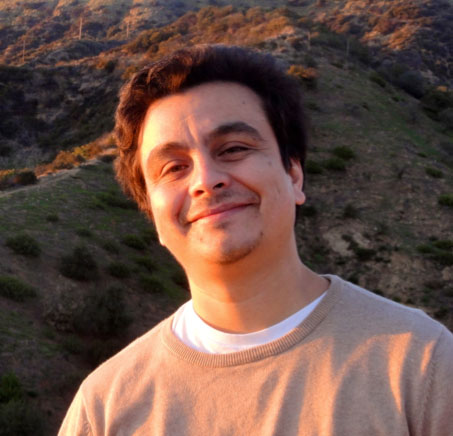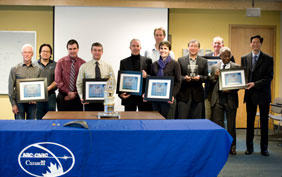NRAO eNews
Volume 5, Issue 3 • March 8, 2012
Upcoming Events
 NRAO Postdoc Symposium
NRAO Postdoc Symposium
Mar 26 - 28, 2012 | Socorro, NM
 Global Properties of HI in Galaxies Workshop
Global Properties of HI in Galaxies Workshop
Apr 1 - 3, 2012 | Green Bank, WV
 Synthesis Imaging Workshop
Synthesis Imaging Workshop
May 29 - Jun 5, 2012 | Socorro, NM
NRAO Director Appointment
Ethan Schreier, AUI President
I am very pleased to announce that Anthony (Tony) Beasley was unanimously approved as the next NRAO Director by the AUI Board of Trustees at its 23-24 February 2012 meeting. The National Science Foundation (NSF) has also approved this appointment, and Tony has accepted. He will start at NRAO on or about 21 May.
As many of you know, Tony has had a long history with NRAO. After receiving his Bachelor's in Physics in 1986 and his Doctorate in Astrophysics in 1991 from the University of Sydney, he joined NRAO as a Postdoctoral Fellow at the Very Long Baseline Array in 1991. He was appointed as a Deputy Assistant Director in 1997, and served as Assistant Director from 1998 to 2000.
In 2000, Tony left NRAO to become Project Manager for the Combined Array for Research in Millimeter-wave Astronomy. In 2004, he returned to NRAO as an Assistant Director, but this time as the Atacama Large Millimeter/submillimeter Array (ALMA) Project Manager at the Joint ALMA Office in Chile. In 2008, Tony joined the National Ecological Observatory Network as Chief Operating Officer and Project Manager.
Despite his brief sabbatical from radio astronomy, Tony has continued to serve on many high profile advisory and review committees, including some with the International Square Kilometre Array project. Tony is widely known and highly respected in the radio astronomy community and at NSF for his professional experience and accomplishments. He has played key roles in the implementation of some the world's most advanced and successful radio astronomy facilities.
Tony returns to NRAO at an exciting and challenging time, succeeding Fred K.Y. Lo, who has served as Director since 2002. With ALMA and the Jansky Very Large Array both starting early science, joining the reinvigorated Green Bank Telescope and Very Long Baseline Array, Tony will build upon the numerous Observatory achievements led by Fred over the past decade. We certainly owe Fred an enormous amount of gratitude for these accomplishments.
During the coming months, Tony and Fred will work closely with the NRAO management team to ensure a smooth transition, and I will personally do everything possible to help. We all look forward to Tony rejoining the AUI/NRAO team, while we thank Fred for his accomplishments.
Observing the Birth of a Relativistic Jet
Ashley Zauderer and Edo Berger (Harvard-Smithsonian Center for Astrophysics)
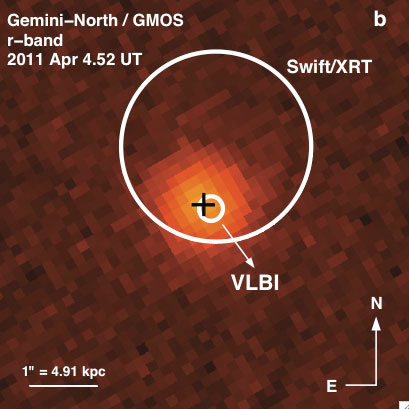
Figure 1: JVLA and VLBI observations at 22 GHz localize the position of the radio afterglow of Swift J1644+57 to be consistent with the nucleus of an inactive galaxy at z = 0.354. The Gemini-North r-band image of the galaxy is shown in color, with the optical centroid indicated with the black crosshair. The large white circle indicates the Swift/XRT 1.4’’ error circle, and the small white circle indicates the radio 22 GHz position (Zauderer et al. 2011, Fig. 1B).
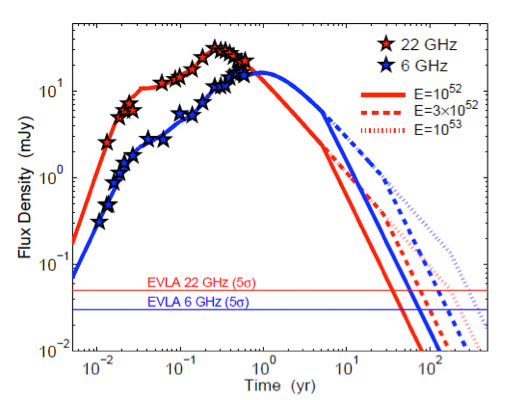
Figure 2: JVLA monitoring of SwJ1644+57 indicates an energy enhancement beginning at ~30 days. Radio observations allow the density structure in the pristine environment around a formerly dormant SMBH to be probed on parsec scales. With the completion of the full JVLA upgrade, SwJ1644+57 will be detectable for ~100 years (Berger et al. 2012, Fig. 8).
The Swift satellite observed an unprecedented event on 28 March 2011, with multiple gamma-ray triggers and rapidly varying X-ray emission with unusually long duration3. The unusual gamma-ray and X-ray emission indicates that this event, SwJ1644+57, was not a gamma ray burst (GRB). SwJ1644+57 also lacked a varying optical counterpart, so classical optical-uv searches would not have been able to identify this event.
Early radio observations were crucial to our overall understanding of this event. We observed this source beginning the day of the initial Swift trigger with the Jansky Very Large Array (JVLA), along with millimeter (CARMA) and sub-millimeter (SMA) radio facilities. The JVLA's newly commissioned WIDAR capabilities led to early observations that clearly indicated a rising spectral index. This observed spectral index was steeper than expected for a typical GRB, and continued rising all the way to the millimeter regime. Additionally, JVLA and VLBI observations at 22 GHz localized the event to the nucleus of a galaxy at z = 0.35 (see Figure 1). This galaxy had no prior evidence of AGN activity and spectral line diagnostics indicate it is a normal star-forming galaxy. Based on the first month of radio observations, we demonstrated the birth of a relativistic jet from the tidal disruption of a solar mass star by a million solar mass SMBH4. Such a process was not anticipated in the standard models of tidal disruption, but our results suggest that it may be ubiquitous. The tidal disruption of stars wandering too close in their orbit to a supermassive black hole (SMBH) has long been theorized1.
We have continued monitoring this event at radio wavelengths, and present the first 200 days of observations in Berger et al. (2012). The observations reveal a late time enhancement in energy and density, and allow the pristine environment around a formerly dormant black hole to be probed with more detailed measurements than even in the Milky Way Galactic Center. The source is not yet resolved with the VLBA, but observations are ongoing. If the source evolves as expected, it will be detectable with the JVLA for ~100 years (see Figure 2). However, with the flux declining, it is a race against time to determine if the source will be resolved with the VLBA prior to it fading too much. Follow-up monitoring is ongoing with the JVLA to measure polarization, determine the properties of the environment around the black hole, and to eventually determine the total energy of this unique event. Our study will moreover shed light on the formation and evolution of relativistic jets from SMBHs, a process that cannot be observed in long-lived AGN.
References1. Rees, M. J., 1988 Nature, 333, 523.
2. Berger, E. et al., 2012 ApJ, accepted.
3. Burrows, A. et al., 2011 Nature, 476, 421.
4. Zauderer, A. et al., 2011 Nature, 476, 425.
Resolution of the Compact Sources in the
Starburst Galaxy Arp220
Fabien Batejat and John E. Conway (Onsala Space Observatory)
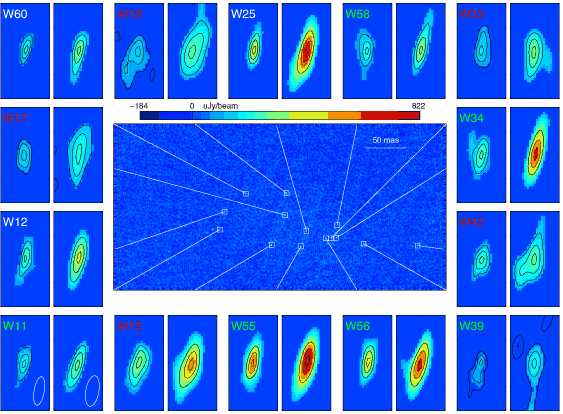
Figure 1: [Central image] The 3.6 cm image (410 x 205 mas) of the western nucleus of Arp220. Fourteen sources were detected above 5.6σ thresholds at 2 and 3.6 cm. [Border images] Zoomed images at 2 and at 3.6 cm, respectively, each 2.1 x 4.1 mas.
 Zoom | Read more details
Zoom | Read more details
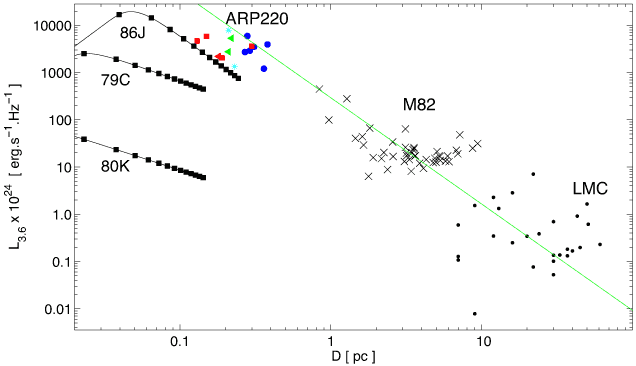
Figure 2: 3.6 cm luminosities and sizes of observed SNe and SNRs. The sources in Arp220, and SNRs in M82 and the LMC are plotted.
 Zoom | Read more details
Zoom | Read more details
Observations of radio supernovae (SNe) and supernova remnants (SNRs) provide an important means to study astrophysical processes occurring in dense nuclear starbursts. Radio observations of these objects are free from the dust obscuration that hamper observations at shorter wavelengths, while the high angular resolution afforded by very long baseline interferometry (VLBI) observations cannot be matched by any other technique. Monitoring the rate of appearance of radio SNe can potentially constrain the stellar initial mass function and check whether it is modified in extremely dense environments such as found in Arp2201. The SNRs are the acceleration sites of the relativistic particles that give rise to radio emission in star-forming regions and hence their properties are central to understanding the far-IR (FIR)-radio correlation2. Finally, radio SNe and SNRs can be used as in situ probes to constrain the interstellar medium (ISM) properties such as density, pressure, and magnetic field strength.
For over a decade the nearest and best studied ultra-luminous infrared galaxy (ULIRG) Arp220 has been the subject of a global VLBI campaign at cm wavelengths1,3,4,5. Batejat et al. (2011) present the results and analysis of new high sensitivity (~30 μJy beam-1) and resolution (~0.5 mas) global VLBI observations at 3.6 cm and 2 cm (Figure 1). The main objectives of these new observations were to extend source spectra to higher frequencies, look for high-frequency variability, and most importantly, attempt to spatially resolve sources or set limits on source sizes.
As a result of these new experiments, 11 of the 17 sources detected at short wavelength have been resolved for the first time at 2 cm, 8 at 3.6 cm, and 7 at both 2 cm and 3.6 cm. Based on their temporal and spectral properties derived from the 13-year monitoring of the starburst in Arp220, Batejat et al. (2011) confirm the claim of Parra et al. (2007) that the compact radio sources mostly comprise a mixed population of SNe and SNRs. Of the 17 sources detected at both wavelengths, 7 are classified as SNe and 6 as SNRs. Two sources are candidate SN/SNR transition objects. Two sources remain difficult to classify and may be AGN components. Ongoing VLBI monitoring at 6 cm should shed further light on the nature of these sources. The sources resolved at both wavelengths (all but one of which are SNRs) have diameters in the range 0.27-0.38 pc with mean 0.31 pc. In comparison the SNe are, except in one case, all unresolved. The observed size boundary between SNe and SNRs is consistent with SNRs just entering their Sedov phase in an ISM density of 104 cm-3. Combining source sizes with source ages, Batejat et al. (2011) calculate upper limits for source expansion velocities averaged over their lifetime. They find expansion velocities < 30,000 km s-1 for the SNe and ~5000 km s-1 for the SNRs.
Batejat et al. (2011) also investigate the magnetic field generation mechanisms in SNRs. Given estimates of source sizes and synchrotron emission flux densities, it is possible to work out minimum energies and equipartition magnetic fields. These authors argue that magnetic fields in the SNRs of Arp220 are internally generated7 and not dominated by compressed ISM magnetic fields8. This interpretation is supported by the fact that the estimated particle energy density is equal to the ram pressure7 and that the relativistic particle total energies in the SNRs fit those needed to explain the FIR-radio correlation2. Based on the conclusion that in SNRs internal magnetic fields dominate over compressed ISM magnetic fields, an upper limit of 7 mG is derived for the ISM magnetic field in Arp220, consistent with other estimates and limits.
Finally, given the sizes measured for the SNRs in Arp220, Batejat et al. (2011) conclude that the observed SNR radio luminosity as a function of diameter for sources in Arp220, M82, and the LMC is in good agreement with the predicted luminosity-diameter relation Lν ∝ D-2.25 (Berezhko & Völk, 2004) as derived assuming internally generated magnetic fields in SNR shells (Figure 2).
Further multi-epoch observations of the compact sources in Arp220 at multiple wavelengths (18, 6, and 3.6 cm) have been conducted and are being analyzed. The goals of this continued monitoring include resolving the classification of ambiguous sources, confirming the 4%/yr flux density decrease we expect for the SNRs expanding in the Sedov phase and trying to characterize and explain the nature of the rapid variability observed in three sources in the western nucleus of Arp220 (see Batejat et al., 2012, in preparation).
References
1. Parra, R., Conway, J. E., Diamond, P. J., et al. 2007, ApJ, 659, 314.
2. Lacki, B. C., Thompson, T. A., & Quataert, E. 2010, ApJ, 717, 1.
3. Smith, H. E., Lonsdale, C. J., Lonsdale, C. J., & Diamond, P. J. 1998, ApJ, 493, L17.
4. Rovilos, E., Diamond, P. J., Lonsdale, C. J., Smith, H. E., & Lonsdale, C. J. 2005, MNRAS, 359, 827.
5. Lonsdale, C. J., Diamond, P. J., Thrall, H., Smith, H. E., & Lonsdale, C. J. 2006, ApJ, 647, 185.
6. Batejat, F., Conway, J. E., Hurley, R., et al. 2011, ApJ, 740, 95.
7. Berezhko, E. G., & Völk, H. J. 2004, A&A, 427, 525.
8. van der Laan, H. 1962, MNRAS, 124, 125.
9. Weiler, K. W., Panagia, N., Montes, M. J., & Sramek, R. A. 2002, ARA&A, 40, 387.
10. Bietenholz, M. F., Bartel, N., & Rupen, M. P. 2002, ApJ, 581, 1132.
11. Huang, Z. P., Thuan, T. X., Chevalier, R. A., Condon, J. J., & Yin, Q. F. 1994, ApJ, 424, 114.
12. Mills, B. Y., Turtle, A. J., Little, A. G., & Durdin, J. M. 1984, Aust. J. Phys., 37, 321.ß
2012 Jansky Fellowships Awarded
C. Carilli, J. UtLey, and M. Goss
The NRAO Jansky Fellowship program provides outstanding opportunities for research in astronomy, and we are pleased to announce that three new Fellows will soon join the program. Jansky Fellows formulate and carry out investigations either independently or in collaboration with others within the wide framework of interests of the Observatory. The program is open each fall to candidates with an interest in radio astronomy instrumentation, computation, and theory, and prior radio experience is not required. Multi-wavelength projects leading to a synergy with NRAO instruments are encouraged.
Michal Drahus, currently a postdoc at UCLA, will be hosted by Caltech as a Jansky Fellow beginning this fall. Michal received his PhD in Astronomy and Astrophysics from the University of Goettingen in June 2009.
He is interested in properties of comets investigated with the modern tools of submillimeter astronomy. In particular, using time-resolved spectroscopy of cometary emission lines, he has studied the rotational dynamics and compositional structure of the nuclei of short-period comets. As a Jansky Fellow, he will extend this program to all classes of comets, with the ultimate goal to better understand the formation, evolution and decay of these bodies. Michal is also excited about the new possibilities that have been recently opened for his research by ALMA.
Laura Pérez, currently a PhD student at Caltech, will begin her Jansky Fellowship at the NRAO in Socorro, New Mexico. Laura expects to receive her PhD in Astrophysics from Caltech in August 2012, and she will join NRAO in the fall.
Her research focuses on characterizing the environments where planets form: proto-planetary disks. As a Jansky Fellow she plans to exploit the high spatial resolution capabilities of the next generation of radio interferometers, Jansky VLA and ALMA, to study several questions related to planet and star formation. She is currently studying one of the first steps toward planet formation: the growth of dust grains to pebbles inside proto-planetary disks, employing multi-wavelength observations that include Early Science JVLA measurements. She will also study transitional disks, thought to be intermediate systems were planets might have already formed. She is very excited about her upcoming ALMA Cycle 0 observations that will study a sample of these objects to understand the origin of the observed cavities in transitional disks.
Chris Hales, currently a PhD student at Sydney University, will begin his Jansky Fellowship at the NRAO in Socorro, New Mexico this fall. Chris expects to be awarded his PhD in Astronomy from Sydney University in late 2012.
During his Fellowship, Chris will use new radio polarimetry statistics to measure magnetic fields in three key environments: Galactic supernova remnants, the intracluster medium of galaxy clusters, and the intergalactic medium in the filaments of large scale structure. Chris proposes to use these observations to investigate properties of cosmic rays and turbulence, and to probe the origins of magnetism in galaxies and clusters using the techniques of radio astronomy and polarization.
2012 NRAO Postdoctoral Fellows
Claire Chandler
In addition to the Jansky Fellowship program NRAO also offers a Postdoctoral Fellow program that provides the opportunity for hands-on training in areas of technical expertise and observatory operations, in addition to offering exciting research opportunities with NRAO facilities. We are very pleased to announce that three NRAO Postdoctoral Fellows will be joining NRAO in 2012, working in areas directly related to the new capabilities provided by the Jansky Very Large Array and the Very Long Baseline Array.
Minnie Mao is currently completing her PhD at the University of Tasmania, where she has focused on studying the cosmic evolution of radio sources in the Australia Telescope Large Area Survey (ATLAS). Minnie plans on using the JVLA, VLBA, and ALMA to understand the role of AGN in the formation and evolution of galaxies, investigate different accretion modes, and disentangle star formation and AGN activity. Minnie has an extensive background in radio interferometry, and will be helping to develop and test the JVLA calibration pipeline while in Socorro.
Walter Max-Moerbeck will be receiving his PhD from Caltech this summer, where he has been studying the high-energy emission mechanism in blazars through monitoring of large blazar samples at gamma ray and radio wavelengths. At NRAO Walter plans to develop enhanced statistical analysis tools needed to understand further the relationship between radio and gamma ray emission from blazars, as well as using the JVLA and VLBA for high resolution monitoring and imaging. While in Socorro he will also help to commission new capabilities on the VLBA.
Huib Intema is currently a Jansky Fellow at NRAO-Charlottesville, where his research has focused on merging galaxy clusters, and proto-clusters associated with high redshift radio galaxies. Huib has also developed special data reduction techniques for wide-field calibration and imaging at low frequencies with direct application to GMRT and WSRT data. In Socorro he plans to extend these studies to the JVLA, while helping to develop the wide-field, wide-band imaging and automated flagging algorithms needed to deliver the full capabilities of the telescope.
NRAO Community Day Events
Carol Lonsdale
With the anticipated due date for ALMA Cycle 1 proposals in July 2012, and the NRAO proposal deadline of 1 August 2012, NRAO and the Office of Observatory Science Operations (OSO) announces an opportunity for the scientific community in North America to organize local NRAO Community Day(s).
We invite community members to submit proposals to host an NRAO Community Day(s) event, a one to two day event organized by the proposers. Our goal is to showcase the NRAO instruments and provide information on how to propose and observe with ALMA, the JVLA, VLBA, and GBT. The NRAO-led portion of the program will involve a brief overview of the capabilities of each of our instruments, including considerations for a successful NRAO proposal. Additional sessions will provide an opportunity for hands-on experience with the various observation preparation tools and post-processing systems.
A proposal should not be longer than one page and must include the following information:
- An anticipated program that provides a summary of science or other presentations that the organizer plans to make, if any.
- The duration of the proposed events, and two or three possible dates.
- The expected location, size of the audience, list of universities and institutions to be served, and advertisement plan.
The NRAO will support the event by providing staff to describe the NRAO facilities and community support programs, and to staff hands-on training sessions. The NRAO-led portion of the event can be expected to take one full day.
We expect to be able to support one or two Community Day event(s) starting in May 2012. Please note that availability of NRAO staff to support ALMA-related sessions is likely to be limited after June 20.
Interested members of the community should contact Anthony Remijan (aremijan@nrao.edu) for further details. Proposals should be sent to the NRAO by 20 April 2012.
ALMA Progress
Al Wootten
During February ALMA science underwent a planned shutdown to install the permanent power supply elements. The turbines that generate the electricity at the Operations Support Facility (OSF) can be operated on diesel or liquid petroleum gas or natural gas. The acceptance review occurred during early February, with provisional acceptance granted. Power is distributed via a 23 kV system to the array at the Array Operations Site (AOS); flywheels can store power for use during peak load periods. Although good progress was made, heavy rains associated with the summer of the second year of the current La Nina pattern produced some damage to the infrastructure, which is being addressed.
Antenna construction continued; twenty-seven stations at the AOS are occupied, including six with Atacama Compact Array 7m antennas. Several 12m antennas now at the OSF are ready for transport to the AOS. Antennas are now being positioned for observations in the ‘extended’ array of Early Science.
Early Science observing will start up again in the latter part of March on a new schedule, with commissioning and Early Science observing during alternate weeks. Monitoring of the status of the array, through checkups on pointing models, baselines and calibrator fluxes, will move to Early Science blocks.
NRAO received 21 proposals for studies of development upgrades to ALMA in response to its 21 November Call for Studies of Proposed Development Upgrades. Proposals were received from 12 PI institutions; a total of 25 institutions are represented among Co-Is. A panel of external reviewers are in the process of refereeing the proposals, for which there was an oversubscription of about a factor of three.
The ninth ALMA Newsletter covers the first period of ALMA Early Science observing. The observatory is working well and is producing excellent data, and progress in constructing the full array continues on schedule. The Newsletter includes a look at the calibration of ALMA in addition to other topics of interest.
This Month @ the NAASC
NAASC Workshop: Outflows, Winds, and Jets
From Young Stars to Supermassive Black Holes, the sixth in a series of workshops, was held 3-6 March in Charlottesville Virginia. 145 participants pondered presentations and engaged in discussion covering the wide range of astrophysical environments in which gas moves at high velocity. Both the origin of the moving gas and its impacts on nearby environments were covered. Presentations will soon be available online; presentations were broadcast in realtime summaries on Twitter (#jets2012).
NRC–HIA Ships the Last ALMA 3mm Cartridge
On 16 February, the National Research Council – Herzberg Institute of Astrophysics (NRC–HIA) in Victoria, British Columbia, Canada, celebrated a major milestone in its ALMA Band 3 (3mm: 84-116 GHz) Receiver project, when the last of the 73 cartridges was shipped to a front end integration center. To mark this culmination of a ten-year project, NRC-HIA hosted a ceremony at its offices in Victoria on 20 February. On hand to help celebrate were Mark McKinnon representing NRAO, Canadian ALMA Project Scientist Christine Wilson, and representatives from the project's industrial partners: Justin Miller and Jack Ng of Nanowave Technologies Inc.; Jeremy Phillips of Daniels Electronics Ltd.; Keith Morrow of K-Tec Industries Ltd.; and Mike Ong, Kory Pollner and Ray Brougham of Prototype Equipment Design. Greg Fahlman, Director General of NRC–HIA, presented certificates of appreciation to the guests. Mark McKinnon presented Project Manager Keith Yeung with an NRAO Outstanding Achievement Award for the Band 3 team in recognition of its completing the project on-time and on-budget.
Radio Astronomy Outreach in South Africa
NAASC Scientist Kartik Sheth participated in a Community Outreach effort that brought information about careers in Astronomy, including ALMA's contribution to radio astronomy. Sheth partnered with South African graduate student, Moses Mogotsi (University of Cape Town), to give presentations at Mondale High School in Mitchell Plains, and at the Center for Science and Technology High School (COSAT) in Khayelistsha reaching over 200 students. The entire effort, which was organized by the Looking At the Distant Universe with the MeerKAT Array (LADUMA) collaboration, reached over 2000 students across Cape Town. Sheth also presented 4 lectures at the IAU sponsored School for Young Astronomers on the topics of galaxy evolution, radio astronomy - mm/submm astronomy, and career / professional development.
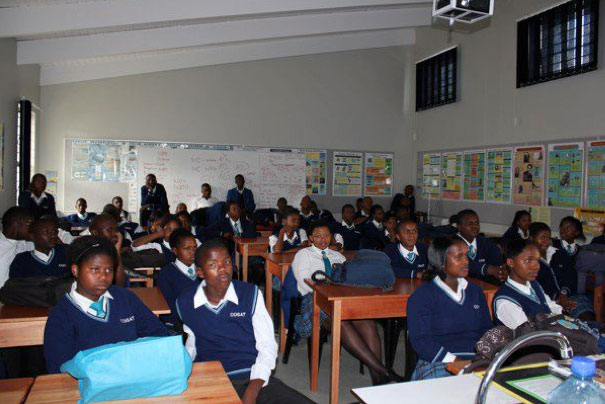
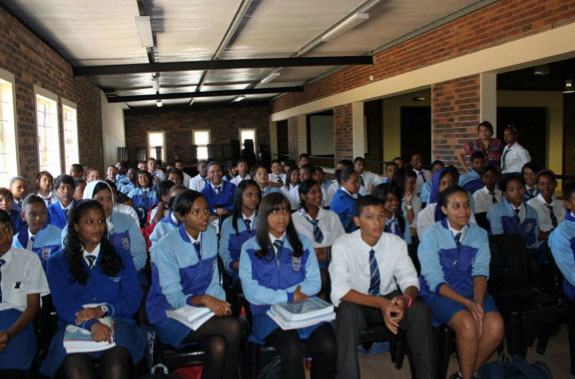
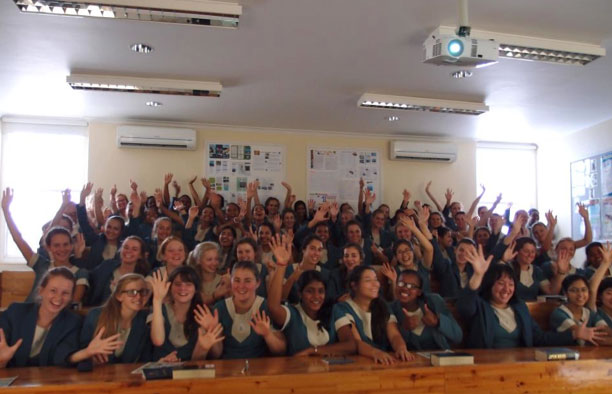
Left to right: COSAT High School in the Khaylitsha Township; Mondale High School; Herschel Girls School
(click on an image to zoom)
Recent Press Releases
 Pulsars: The Universe's Gift to Physics
Pulsars: The Universe's Gift to Physics
19 February 2012
Pulsars, superdense neutron stars, are perhaps the most extraordinary physics laboratories in the Universe. Research on these extreme and exotic objects already has produced two Nobel Prizes. Pulsar researchers now are poised to learn otherwise-unavailable details of nuclear physics, to test General Relativity in conditions of extremely strong gravity, and to directly detect gravitational waves with a "telescope" nearly the size of our Galaxy. Read More …
 From Earth's Water to Cosmic Dawn: New Tools Unveiling Astronomical Mysteries
From Earth's Water to Cosmic Dawn: New Tools Unveiling Astronomical Mysteries
17 February 2012
Two new and powerful research tools are helping astronomers gain key insights needed to transform our understanding of important processes across the breadth of astrophysics. The Atacama Large Millimeter/submillimeter Array (ALMA), and the newly-expanded Karl G. Jansky Very Large Array (VLA) offer scientists vastly improved and unprecedented capabilities for frontier research. Read more …
Career Opportunities
New Postings
Assistant Director, ALMA North American Operations: The NRAO in Charlottesville, Virginia is seeking an Assistant Director for ALMA North American Operations to ensure ALMA NA operations achieve maximum scientific and cost effectiveness of ALMA, and to work in close coordination with the NRAO Director.
Assistant Director, Coordinated Development Lab: The NRAO in Charlottesville, Virginia is recruiting for an Assistant Director for its Coordinated Development Laboratory (CDL). The Head of the Observatory-wide CDL will provide vision and leadership and address key technical challenges of the next generation of instruments while maintaining the performance of current NRAO facilities at state of the art.
Deputy Division Head: The NRAO in Socorro, New Mexico is recruiting for a Deputy Division Head responsible for assisting the Division Head by carrying out engineering analysis, budget, schedule, and general execution of major projects and systems. The responsibilities of the Deputy Division Head include decisions, recommendations and coordination of such aspects as design, procurement, manufacture, test and some degree of initial operation.
Tenure Track Astronomer: The NRAO in Charlottesville, Virginia is recruiting for a tenure track Astronomer. The tenure track astronomer system at the NRAO parallels the tenure track system in research universities, with the support of the science mission of the Observatory substituting for teaching. Astronomers are expected to assume a leading role at the Observatory, and in the wider astronomical community.
Test Scientist – ALMA: The Joint ALMA Observatory (JAO) in Santiago, Chile invites applications for a Test Scientist to participate in system tests during the Assembly, Integration Verification and Maintenance Verification processes. The Test Scientist will be part of the team responsible for ensuring that appropriate testing has been accomplished to verify that system requirements are met.
Co-op Student: The NRAO in Socorro, New Mexico is accepting applications for a Co-op student. The work assignment will involve the location, identification, and logging of chemical materials in use at the VLA site, and the organization and re-publication of Material Safety Data Sheets (MSDS). This position is temporary full-time for a period of three months.
Software Engineer II: The NRAO in Socorro, NM is accepting applications for a Software Engineer II. The successful candidate will work on one or more of the following applications: Observation Preparation Tool, Observation Scheduling Tool, and Archive Access Tool as well as perform routine maintenance and add new features to these tools. Initially the Software Engineer II will work primarily, but not exclusively, on user interface code for our web applications.
Library News
Marsha Bishop
Kai Groner and Lance Utley have been working overtime to make available the new NRAO publications bibliography, NRAOPapers, which contains enhanced bibliographic records for 18,000+ papers using NRAO telescopes or with NRAO authors from 1957 to today. Records are added to NRAOPapers at least weekly and the statistics resulting from these records are provided to NSF and are available in a dynamic chart.
The NRAO Library has also developed an online form for publication support requests that is available from the Publications Support page under Submitting Publication Support Requests. This form should save time for the author yet results in as timely a response on publication support as present.
As a reminder, the NRAO Library provides electronic access to 200+ journals, books (Safari, Knovel and Springer Astronomy and Astrophysics collections), conferences (ASP, IEEE, IEL, etc.), and reports (NASA, etc.).
Information request and requests for materials outside the paper or electronic collections can be submitted to libweb@nrao.edu. Page charge questions can be submitted to library@nrao.edu.
New Collections in the Archives
Ellen Bouton
The NRAO Archives is pleased to announce the availability of three new collections.
The Papers of Bernard F. Burke: Dr. Burke received his undergraduate physics degree from Massachusetts Institute of Technology (MIT) in 1950 and his Ph. D. in physics, also from MIT, in 1953. From 1953-1965 he was a staff member at Carnegie Institution of Washington, then joined the MIT faculty as Professor of Physics, and is now William A. M. Burden Professor of Astrophysics Emeritus. The collection includes Burke's papers related to his radio astronomy research, to both ground-based and space very long baseline interferometry, including Quasat and RadioAstron, and to his service on a variety of councils and committees.
The Papers of Arthur M. Shalloway: Mr. Shalloway received his Bachelor of Science in Electrical Engineering (Communications) from Georgia Institute of Technology in October 1943, and his Master of Science in Electrical Engineering (Electronics) from Georgia Institute of Technology in June 1951. He joined the NRAO staff in 1962 and retired in 1983. During his time at NRAO, Shalloway was instrumental in the design and development of NRAO autocorrelation receivers models I-V and the VLA correlator prototype, as well as VLBI and data communications switch system and facsimile network design. After retirement, he served as a consultant on the design and development of the VLBA correlator. The collection includes selected papers related to Shalloway's work.
We are very grateful to both Dr. Burke and Mr. Shalloway for their donations.
The Observer: This in-house NRAO newsletter, published from December 1961 through October 1981, included articles from all sites on NRAO instrument construction and modification, technical achievements, social and sporting events, and local history, as well as informal science articles, such as the three-article series on the first US-USSR VLBI experiment. The Observer was illustrated with photographs and drawings, and regularly included photographs of new employees. Each issue of The Observer has been scanned and issues are now available in text-searchable PDF. An individual issue listing is available on-line, and in the finding aid for the Records of NRAO.
Collections in the NRAO Archives are all listed on the main Archives web page.
From the Archives
Ellen Bouton
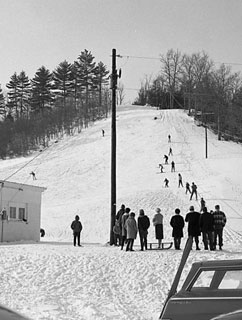
About this month's photo: Skiing on a slope near the Hannah House in Green Bank, February 1966. An unsigned poem, appearing at the end of the previous winter in the 31 March 1965 issue of The Observer began:
By Hannah's manse did Dr. M
A fiendish rope device decree
Where Deer, the sacred river ran
Through valleys measureless to man
Down to a sunless sea.
So three score yards of fertile ground
With poles and ropes were girdled around:
Upon this slope, dug with pneumatic drills
There blossomed many a car-wheel-bearing tree;
Here was a motor, ancient as the hills
Puffing black smoke upon the scenery.
This was followed by several additional verses of equal merit.
From the Archives is an ongoing series illustrating NRAO and U.S. radio astronomy history via images selected from our collections of individuals' and institutional papers. If readers have images they believe would be of interest to the Archives, please contact Ellen Bouton, ebouton@nrao.edu.

